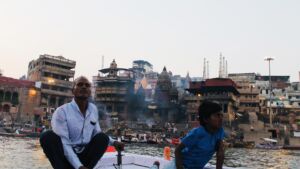Picture: The burning Ghat, view from my Boat!
My heartfelt thwacked, with ceaseless fear, the beats were fast-paced and I could feel a cold ….. there were profuse sweating and effervescence of emotions, running down my veins. The chants seemed to come closer, and my views becoming clearer, the bodies lain dead, being brought one after the other, in a ritualistic manner… on pyres, they will be lit to turn into Ashes. The families pay respects one last time, for they are gone now forever and will see them no more!
Those eyes are gleamy, dark and deep… remorseful and tense, innumerable sights, innumerable stories, innumerable cold bodies, innumerable tourists… Yes… This is the story of Pintoo, who has seen twelve summers and is the ” Naav Wala” ( Boatman/Boat child rather), rowing me down the holy Ganges, to the Manikarnika Ghat.
There live people in Manikarnika, who eat food that’s cooked on the wood that is got from the burning pyre, The Dom Raja Community, considers it Dharma to be doing this job, ritualistic, prescribed set of rules followed and brought down through ages. This community are one of its kind, Brahmins, who are considered untouchables, for their job is to “Burn the Dead”

Pintoo, my Naav Wala. We had stopped to see the Shivala Ghat

Watching the Mortal remains burn

Manikarnika Ghat

The rituals at Manikarnika ghat

The crowd gathered to watch them burn, Death tourism

The rituals at Manikarnika ghat

The Submerged temple near Manikarnika Ghat
My Naav Wala tells me, “we see 50 bodies being set on fire, on the Manikarnika sometimes, we bring tourists to witness this, we congregate in boats and row them to this point, vying to take the right spot. Closer to the Ghats, is the better view! ”
It reminded me of a Chinese proverb, ” I cried because I had no shoes until I saw a man who had no feet” ( Author Unknown). Sometimes we fail to realise how blessed our lives are. I have started to count my blessings, not my monies… My Naav Wala transformed me and redefined my thoughts.
The inscription on a wall, on the Manikarnika, reads, ( Extracted from Banaras, City of Lights by Diana L. Eck )
This is Manikarnika, where death is auspicious,
Where life is fruitful,
Where one gazes at the pastures of heaven.
As written in Matsya Purana and Kashi Khanda, ” A man leaves his body at Manikarnika, reaches the desired goal. Manikarnika is said to be a place where people surrender their earthly bodies to death and receive spiritual bodies like that of Shiva himself, and this is a place where one might wish to DIE!”
I am writing this article after a year of my visit to Banaras and of meeting my Boatman, but what astounds me is that those eyes keep passing in front of my face, like lightning strikes, swooshing. The ethereal look, confused and with too many questions… Even when I was in constant conversation with this child, his eyes caught my attention. He was vigilant, he kept staring at the ghats while on the boat, he kept staring into the waters now and then, and his eyes searched for the best spot for anchoring the boat so that I could witness, from the river, the act of “Death Tourism”. Yes, there exists Death Tourism too, for I wonder, how the multiplier effects of it would reach one of the stakeholders, the Dead Bodies?, who according to the “Ghatias” (the one who lives and serves on the ghats) are looking upon us from the heavens!
Is Banaras a real world?














